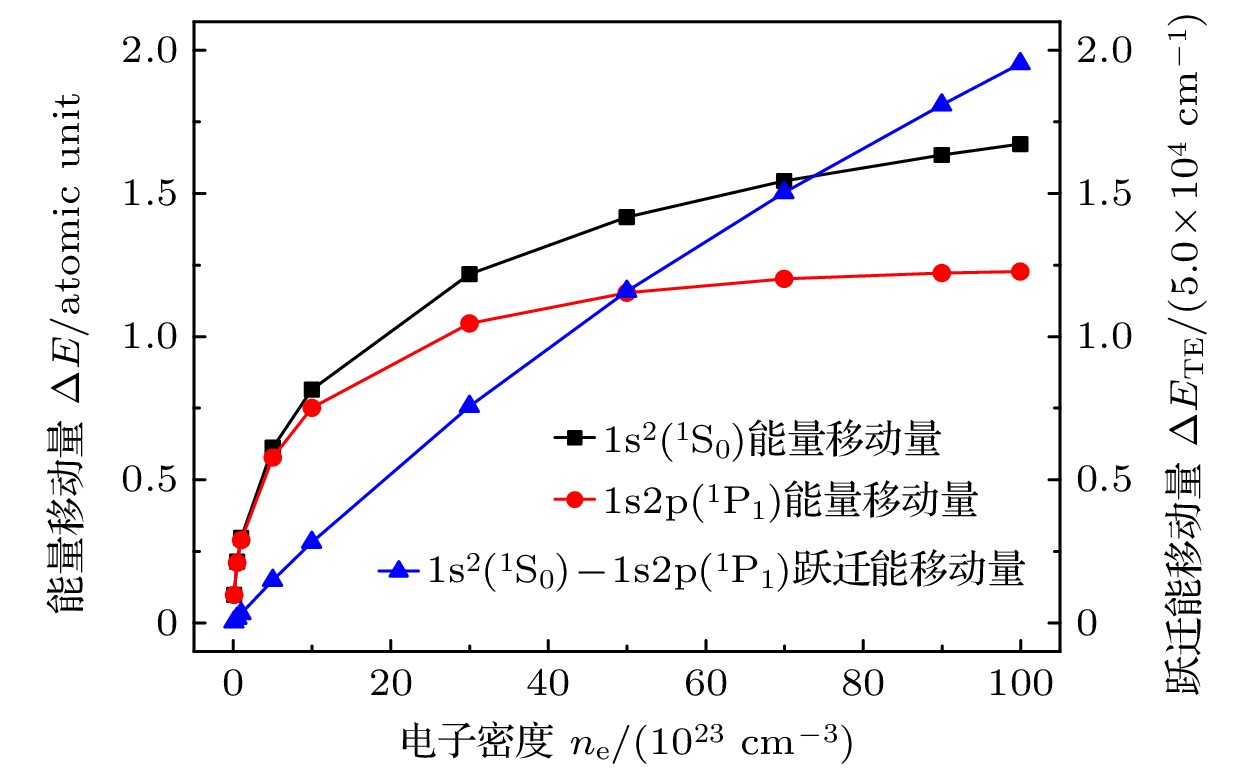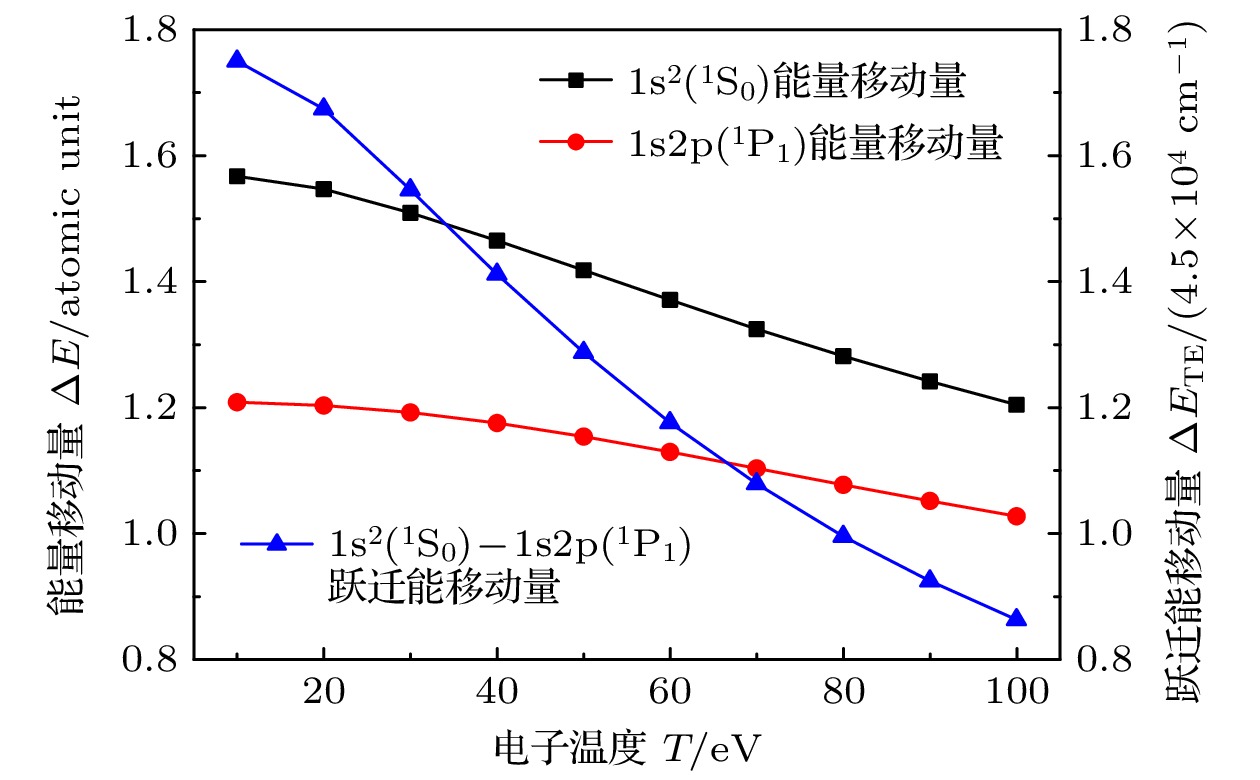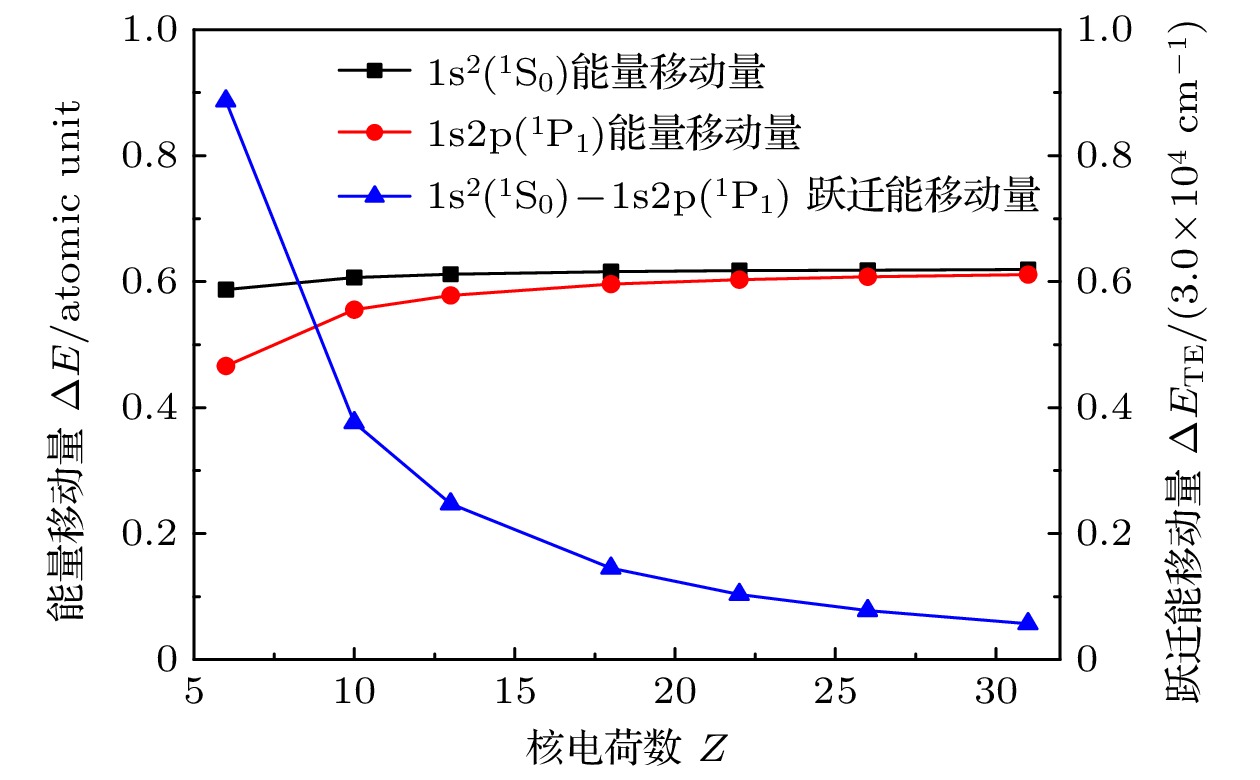-
在计算等离子体环境中的原子结构时, 一般情况下只考虑等离子体对核-电子相互作用的屏蔽, 较少考虑其对电子-电子相互作用的屏蔽. 本文采用MCDHF (multi-configuration Dirac-Hartree-Fork)方法结合屏蔽势研究了电子-电子相互作用的等离子体屏蔽对原子结构参数的影响随电子密度、电子温度、核电荷数和束缚电子个数的变化规律. 结果表明, 对于类氦离子的基态和第一激发态, 等离子体对电子-电子相互作用的屏蔽引起的能量移动量、跃迁能移动量和跃迁几率移动量分别随着电子密度和电子温度的升高而不断增大和减小; 随着核电荷数的增大, 能量移动量逐渐增大并趋于稳定值, 跃迁能移动量和跃迁几率移动量逐渐减小并趋于0. 能量移动量随着束缚电子个数的增加而增大. 当满足电子密度(束缚电子个数)大于或者等于其临界值以及电子温度(核电荷数)小于或者等于其临界值任意一条件时, 等离子体对电子-电子相互作用的屏蔽效应不可忽略.In the calculation of atomic structures within the plasma environment, the plasma screening effect on nuclei - electron interactions is generally considered, but the plasma screening effect on electron - electron interactions is less considered. In this work, the MCDHF method combined with the screening potential is used to study plasma screening effect on the atomic structure parameters versus the electron density, electron temperature, nuclear charge and the number of bound electrons. For the ground states and the first excited states of helium-like ions, the energy shifts, transition energy shifts and transition probability shifts caused by the plasma screening effect on electron-electron interactions increase with the increase of electron densities and decrease with increasing the electron temperatures, respectively. With the increase of nuclear charge, the energy shifts increase gradually and tends to a stable value, while the transition energy shifts and transition probability shifts decrease gradually and tend to 0. The energy shifts increase with the increase of the number of bound electrons. The electron density, electron temperature, nuclear charge and number of bound electrons corresponding to the percentages of transition energy shifts and transition probability shifts caused by plasma screening on electron-electron interactions greater than or equal to 10%, are called as the critical electron density, critical electron temperature, critical nuclear charge and critical number of bound electrons, respectively. When one of the following four conditions is satisfied, the percentages of transition energy shifts and transition probability shifts caused by plasma screening on electron-electron interactions will be greater than or equal to 10%, and the plasma screening effect on electron - electron interactions can not be ignored. 1) The electron density is greater than or equal to the critical electron density, when the electron temperature is a fixed value. 2) The electron temperature is less than or equal to the critical electron temperature, when the electron density is a fixed value. 3) The nuclear charge is less than or equal to the critical nuclear charge, when the electron density and temperature are both fixed. 4) The number of bound electrons is greater than or equal to the critical number of bound electrons, when the electron density and temperature are both fixed.
-
Keywords:
- plasma /
- MCDHF method /
- screening potential /
- structural parameters
[1] Dornheim T, Groth S, Bonitz M 2018 Phys. Rep. 744 1
 Google Scholar
Google Scholar
[2] Glenzer S H, Redmer R 2009 Rev. Mod. Phys. 81 1625
 Google Scholar
Google Scholar
[3] Das M, Sahoo B K, Pal S 2016 Phys. Rev. A 93 052513
 Google Scholar
Google Scholar
[4] 李博文, 蒋军, 董晨钟, 王建国, 丁晓彬 2009 58 5274
 Google Scholar
Google Scholar
Li B W, Jiang J, Dong C Z, Wang J G, Ding X B 2009 Acta Phys. Sin. 58 5274
 Google Scholar
Google Scholar
[5] Hu S X 2017 Phys. Rev. Lett. 119 065001
 Google Scholar
Google Scholar
[6] Papoulia A, Schiffmann S, Bieron J, Gaigalas G, Godefroid M, Harman Z, Jönsson P, Oreshkina N S, Pyykk P, Tupitsyn I I 2021 Phys. Rev. A 103 022815
 Google Scholar
Google Scholar
[7] 马堃, 陈展斌, 黄时中 2019 68 023102
 Google Scholar
Google Scholar
Ma K, Chen Z B, Huang S Z 2019 Acta Phys. Sin. 68 023102
 Google Scholar
Google Scholar
[8] Janev R K, Zhang S B, Wang J G 2016 Matter and Radiation at Extremes 1 237
 Google Scholar
Google Scholar
[9] Qi Y Y, Ning L N 2014 Phys. Plasmas 21 033301
 Google Scholar
Google Scholar
[10] Qi Y Y, Wu Y, Wang J G 2009 Phys. Plasmas 161 033507
[11] Sahoo S, Ho Y K 2006 Phys. Plasmas 13 063301
 Google Scholar
Google Scholar
[12] Kang S, He J, Xu N, Chen C Y 2014 Commun. Theor. Phys. 62 881
 Google Scholar
Google Scholar
[13] Li H W, Kar S 2012 Phys. Plasmas 19 073303
 Google Scholar
Google Scholar
[14] Li Y Q, Wu J H, Hou Y, Yuan J M 2008 J. Phys. B: At. Mol. Opt. Phys. 41 145002
 Google Scholar
Google Scholar
[15] Li X D, Rosmej F B 2012 EPL 99 33001
 Google Scholar
Google Scholar
[16] Li X D, Rosmej F B 2020 Phys. Lett. A 384 126478
 Google Scholar
Google Scholar
[17] White A J, Collins L A 2020 Phys. Rev. Lett. 125 055002
 Google Scholar
Google Scholar
[18] Stanton L G, Murillo M S 2015 Phys. Rev. E 91 033104
 Google Scholar
Google Scholar
[19] Zhang S B, Wang J G, Janev R K 2010 Phys. Rev. Lett. 104 023203
 Google Scholar
Google Scholar
[20] 李永强, 吴建华, 袁建民 2008 57 4042
 Google Scholar
Google Scholar
Li Y Q, Wu J H, Yuan J M 2008 Acta Phys. Sin. 57 4042
 Google Scholar
Google Scholar
[21] Li B W, Dong C Z, Jiang J, Wang J G 2010 Plasma Sci. Technol. 12 372
[22] Kar S, Ho Y K 2009 J. Phys. B: At. Mol. Opt. Phys. 42 044007
 Google Scholar
Google Scholar
[23] Mukherjee P K, Karwowski J, Diercksen Geerd H F 2002 Chem. Phys. Lett. 363 323
 Google Scholar
Google Scholar
[24] Chen C, Zhao G P, Qi Y Y, Liu L, Chen Z B, Wang J G 2022 Phys. Plasmas 29 072901
 Google Scholar
Google Scholar
[25] Chen Z B, Qi Y Y, Sun H Y, Zhao G P, Liu P F, Wang K 2020 J. Quant. Spectrosc. Radiat. Transfer 3 8
[26] Zhao G P, Xie L Y, Liu L, Wang J G, Janev R K 2018 Phys. Plasmas 25 083302
 Google Scholar
Google Scholar
[27] Zhao G P, Liu L, Wang J G, Janev R K, Yan J 2018 Matter and Radiation at Extremes 3 300
 Google Scholar
Google Scholar
[28] Zhao G P, Liu L, Wang J G, Janev R K 2017 Phys. Plasmas 24 053509
 Google Scholar
Google Scholar
[29] Zhao G P, Liu L, Wang J G, Janev R K 2017 Phys. Plasmas 24 103504
 Google Scholar
Google Scholar
[30] Li W G, Cheng Y J, Wu J Y, Wu Y, Wang J G, Zhang S B 2021 Phys. Plasmas 28 012708
 Google Scholar
Google Scholar
[31] Murillo M S, Weisheit J C 1998 Phys. Rep. 302 1
 Google Scholar
Google Scholar
[32] Ichimaru S 1982 Rev. Mod. Phys. 54 1017
 Google Scholar
Google Scholar
[33] Shukla P K, Eliasson B 2008 Phys. Lett. A 372 2897
 Google Scholar
Google Scholar
[34] [35] Jönsson P, Gaigalas G, Bieroń J, Fischer C F, Grant I P 2013 Comput. Phys. Commun. 184 2197
 Google Scholar
Google Scholar
[36] Jönsson P, He X, Fischer C F, Grant I P 2007 Comput. Phys. Commun. 177 597
 Google Scholar
Google Scholar
[37] Xie L Y, Wang J G, Janev R K, Qu Y Z, Dong C Z 2012 Eur. Phys. J. D 66 125
 Google Scholar
Google Scholar
[38] Chen Z B, Ma K, Hu H W, Wang K 2018 Phys. Plasmas 25 072120
 Google Scholar
Google Scholar
[39] Saha B, Fritzsche S 2006 Phys. Rev. E 73 036405
 Google Scholar
Google Scholar
-
图 1 当电子温度为50 eV时,
$ {\rm{Al}}^{11+} $ 离子$ {\rm{1}}{{\rm{s}}^{\rm{2}}}{(^{\rm{1}}}{{{\rm{S}}}_{\rm{0}}}) $ 和$ {\rm{1 s2 p}}{(^{\rm{1}}}{{{\rm{P}}}_{\rm{1}}}) $ 原子态的能量移动量以及$ {\rm{1}}{{\rm{s}}^{\rm{2}}}{(^{\rm{1}}}{{{\rm{S}}}_{\rm{0}}}) $ —$ {\rm{1 s2 p}}{(^{\rm{1}}}{{{\rm{P}}}_{\rm{1}}}) $ 的跃迁能移动量随电子密度的变化Fig. 1. Energy shifts of
$ {\rm{1}}{{\rm{s}}^{\rm{2}}}{(^{\rm{1}}}{{{\rm{S}}}_{\rm{0}}}) $ and$ {\rm{1 s2 p}}{(^{\rm{1}}}{{{\rm{P}}}_{\rm{1}}}) $ atomic states, and the transition energy shifts of$ {\rm{1}}{{\rm{s}}^{\rm{2}}}{(^{\rm{1}}}{{{\rm{S}}}_{\rm{0}}}) $ –$ {\rm{1 s2 p}}{(^{\rm{1}}}{{{\rm{P}}}_{\rm{1}}}) $ transition for$ {\rm{Al}}^{11+} $ ions vary with electron densities, when the electron temperature is equal to 50 eV图 2 当电子密度为
$ 5.0\times10^{24}\;{\rm{cm}}^{-3} $ 时,$ {\rm{Al}}^{11+} $ 离子$ {\rm{1}}{{\rm{s}}^{\rm{2}}}{(^{\rm{1}}}{{{\rm{S}}}_{\rm{0}}}) $ 和$ {\rm{1 s2 p}}{(^{\rm{1}}}{{{\rm{P}}}_{\rm{1}}}) $ 原子态的能量移动量以及$ {\rm{1}}{{\rm{s}}^{\rm{2}}}{(^{\rm{1}}}{{{\rm{S}}}_{\rm{0}}}) $ —$ {\rm{1 s2 p}}{(^{\rm{1}}}{{{\rm{P}}}_{\rm{1}}}) $ 的跃迁能移动量随电子温度的变化Fig. 2. Energy shifts of
$ {\rm{1}}{{\rm{s}}^{\rm{2}}}{(^{\rm{1}}}{{{\rm{S}}}_{\rm{0}}}) $ and$ {\rm{1 s2 p}}{(^{\rm{1}}}{{{\rm{P}}}_{\rm{1}}}) $ atomic states, and the transition energy shifts of$ {\rm{1}}{{\rm{s}}^{\rm{2}}}{(^{\rm{1}}}{{{\rm{S}}}_{\rm{0}}}) $ –$ {\rm{1 s2 p}}{(^{\rm{1}}}{{{\rm{P}}}_{\rm{1}}}) $ transition for$ {\rm{Al}}^{11+} $ ions vary with electron temperatures, when the electron density is equal to$ 5.0 \times 10^{24}\;{\rm{cm}}^{-3} $ 图 3 当电子密度和温度分别为
$ 5.0\times10^{23}\;{\rm{cm}}^{-3} $ 和50 eV时, 类氦离子(Z = 6, 10, 13, 18, 22, 26, 31)$ {\rm{1}}{{\rm{s}}^{\rm{2}}}{(^{\rm{1}}}{{{\rm{S}}}_{\rm{0}}}) $ 和$ {\rm{1 s2 p}}{(^{\rm{1}}}{{{\rm{P}}}_{\rm{1}}}) $ 原子态的能量移动量以及$ {\rm{1}}{{\rm{s}}^{\rm{2}}}{(^{\rm{1}}}{{{\rm{S}}}_{\rm{0}}}) $ —$ {\rm{1 s2 p}}{(^{\rm{1}}}{{{\rm{P}}}_{\rm{1}}}) $ 的跃迁能移动量随核电荷数Z的变化Fig. 3. Energy shifts of
$ {\rm{1}}{{\rm{s}}^{\rm{2}}}{(^{\rm{1}}}{{{\rm{S}}}_{\rm{0}}}) $ and$ {\rm{1 s2 p}}{(^{\rm{1}}}{{{\rm{P}}}_{\rm{1}}}) $ atomic states, and the transition energy shifts of$ {\rm{1}}{{\rm{s}}^{\rm{2}}}{(^{\rm{1}}}{{{\rm{S}}}_{\rm{0}}}) $ –$ {\rm{1 s2 p}}{(^{\rm{1}}}{{{\rm{P}}}_{\rm{1}}}) $ transition for He-like ions (Z = 6, 10, 13, 18, 22, 26, 31) vary with nuclear charge Z, when the electron density and temperature are$ 5.0\times10^{23}\;{\rm{cm}}^{-3} $ and 50 eV respectively表 1 电子温度为50 eV时,
${\rm{C}}^{4+}$ 离子$1 {\rm{s}}^2(^1 {\rm{S}}_0)$ 原子态的能量随电子密度的变化Table 1. Energies of
${\rm{1 s}}^2(^1 {\rm{S}}_0)$ atomic state for${\rm{C}}^{4+}$ ions vary with electron densities, when the electron temperature is 50 eV电子密度/$\;{\rm{cm}}^{-3}$ 德拜屏蔽强度 模型A 模型B $E_ {\rm{DB}}$ $E_ {\rm{DB}}$[37] $E_ {\rm{SM}}$ $E_ {\rm{DB}}$ $E_ {\rm{DB}}$[37] $E_ {\rm{SM}}$ 9.87(19) 0.01 –32.3007 –32.2978 –32.3008 –32.3106 –32.3079 –32.3108 3.95(20) 0.02 –32.1811 –32.1783 –32.1817 –32.2011 –32.1982 –32.2016 2.47(21) 0.05 –31.8245 –31.8215 –31.8282 –31.8740 –31.8711 –31.8775 9.87(21) 0.1 –31.2363 –31.2324 –31.2511 –31.3345 –31.3306 –31.3482 1.54(22) 0.125 –30.9451 –30.9412 –30.9680 –31.0673 –31.0633 –31.0885 3.95(22) 0.2 –30.0830 –30.0790 –30.1395 –30.2758 –30.2717 –30.3284 6.17(22) 0.25 –29.5177 –29.5137 –29.6041 –29.7565 –29.7523 –29.8370 8.88(22) 0.3 –28.9597 –28.9557 –29.0814 –29.2436 –29.2394 –29.3571 1.58(23) 0.4 –27.8653 –27.8614 –28.0730 –28.2372 –28.2328 –28.4309 2.47(23) 0.5 –26.7992 –26.7963 –27.1109 –27.2557 –27.2522 –27.5467 3.55(23) 0.6 –25.7604 –25.7576 –26.1932 –26.2986 –26.2948 –26.7027 注1: $E_ {\rm{DB}}$表示用德拜模型计算的能量 注2: $E_ {\rm{SM}}$表示用SM模型计算的能量 表 2 等离子体对电子-电子相互作用屏蔽引起
$\rm{Al}^{11+}$ 离子$1 {\rm{s}}^2$ ($^1 {\rm{S}}_0$ )—1s2p($^1 {\rm{P}}_1$ )跃迁能移动量和跃迁几率移动量所占百分比随电子密度和温度的变化.Table 2. The variation of percentages of the transition energy shifts and transition probability shifts of
${\rm{1 s}}^2$ ($^1 {\rm{S}}_0$ )–1s2p($^1 {\rm{P}}_1$ ) transition for Al11+ ions caused by plasma screening on electron-electron interaction as a function of plasma electron density and temperature电子温度为50 eV 电子密度为$5.0\times 10^{24}\;{\rm{cm}}^{-3}$ 电子密度
/$\;{\rm{cm}}^{-3}$${\text{%}} \Delta E_ {\rm{TE} }$ ${\text{%} } \Delta A$ 温度/eV ${\text{%} }\Delta E_ {\rm{TE} }$ ${\text{%} } \Delta A$ 1.0(22) 7.53 7.84 10 8.72 10.30 5.0(22) 7.51 7.59 20 8.68 10.20 1.0(23) 7.52 7.63 30 8.60 9.99 5.0(23) 7.60 7.80 40 8.50 9.73 1.0(24) 7.70 8.00 50 8.39 9.48 3.0(24) 8.08 8.77 60 8.29 9.24 5.0(24) 8.39 9.48 70 8.19 9.04 7.0(24) 8.66 10.17 80 8.11 8.88 9.0(24) 8.91 10.86 90 8.04 8.74 1.0(25) 9.04 11.27 100 7.98 8.62 表 3 当电子密度和温度分别为
$4.0\times10^{23}\;{\rm{cm}}^{-3}$ 和50 eV时, 不同电荷态Al离子的基态能量移动量和其所占百分比Table 3. Ground state energy shifts and their percentages of Al ions with different charge when the electron density and temperature are
$4.0\times10^{23}\;{\rm{cm}}^{-3}$ and 50 eV respectively离子 束缚电子个数 原子态 ∆E/atomic unit %∆E 束缚电子对个数 ∆EEP/atomic unit ${\rm{Al}}^{11+}$ 2 ${\rm{1}}{{\rm{s}}^{\rm{2}}}{(^{\rm{1}}}{{{\rm{S}}}_{\rm{0}}})$ 0.556 3.83 1 0.556 ${\rm{Al}}^{10+}$ 3 $\rm{1 s^22 s(^2 S_{1/2})}$ 1.590 7.47 3 0.530 ${\rm{Al}}^{9+}$ 4 $\rm{1 s^22 s^2(^1 S_0)}$ 3.119 11.14 6 0.520 ${\rm{Al}}^{8+}$ 5 $\rm{1 s^22 s^22 p(^2 P_{1/2})}$ 5.152 14.82 10 0.515 ${\rm{Al}}^{7+}$ 6 $\rm{1 s^22 s^22 p^2(^3 P_0)}$ 7.662 18.48 15 0.511 ${\rm{Al}}^{6+}$ 7 $\rm{1 s^22 s^22 p^3(^4 S_{3/2})}$ 10.635 22.11 21 0.506 ${\rm{Al}}^{5+}$ 8 ${\rm{1}}{{\rm{s}}^{\rm{2}}}{\rm{2}}{{\rm{s}}^{\rm{2}}}{\rm{2}}{{\rm{p}}^{\rm{4}}}{(^{\rm{3}}}{{\rm{P}}_{\rm{2}}})$ 14.036 25.71 28 0.501 ${\rm{Al}}^{4+}$ 9 ${\rm{1}}{{\rm{s}}^{\rm{2}}}{\rm{2}}{{\rm{s}}^{\rm{2}}}{\rm{2}}{{\rm{p}}^{\rm{5}}}{(^{\rm{2}}}{{\rm{P}}_{{\rm{3/2}}}})$ 17.948 29.38 36 0.499 注1: %∆E表示等离子体对电子-电子相互作用的屏蔽而引起的能量移动量与其对核-电子相互作用的屏蔽而引起的能量移动量的百分比. 注2: ∆EEP表示总能量移动值对束缚电子对个数的平均值. -
[1] Dornheim T, Groth S, Bonitz M 2018 Phys. Rep. 744 1
 Google Scholar
Google Scholar
[2] Glenzer S H, Redmer R 2009 Rev. Mod. Phys. 81 1625
 Google Scholar
Google Scholar
[3] Das M, Sahoo B K, Pal S 2016 Phys. Rev. A 93 052513
 Google Scholar
Google Scholar
[4] 李博文, 蒋军, 董晨钟, 王建国, 丁晓彬 2009 58 5274
 Google Scholar
Google Scholar
Li B W, Jiang J, Dong C Z, Wang J G, Ding X B 2009 Acta Phys. Sin. 58 5274
 Google Scholar
Google Scholar
[5] Hu S X 2017 Phys. Rev. Lett. 119 065001
 Google Scholar
Google Scholar
[6] Papoulia A, Schiffmann S, Bieron J, Gaigalas G, Godefroid M, Harman Z, Jönsson P, Oreshkina N S, Pyykk P, Tupitsyn I I 2021 Phys. Rev. A 103 022815
 Google Scholar
Google Scholar
[7] 马堃, 陈展斌, 黄时中 2019 68 023102
 Google Scholar
Google Scholar
Ma K, Chen Z B, Huang S Z 2019 Acta Phys. Sin. 68 023102
 Google Scholar
Google Scholar
[8] Janev R K, Zhang S B, Wang J G 2016 Matter and Radiation at Extremes 1 237
 Google Scholar
Google Scholar
[9] Qi Y Y, Ning L N 2014 Phys. Plasmas 21 033301
 Google Scholar
Google Scholar
[10] Qi Y Y, Wu Y, Wang J G 2009 Phys. Plasmas 161 033507
[11] Sahoo S, Ho Y K 2006 Phys. Plasmas 13 063301
 Google Scholar
Google Scholar
[12] Kang S, He J, Xu N, Chen C Y 2014 Commun. Theor. Phys. 62 881
 Google Scholar
Google Scholar
[13] Li H W, Kar S 2012 Phys. Plasmas 19 073303
 Google Scholar
Google Scholar
[14] Li Y Q, Wu J H, Hou Y, Yuan J M 2008 J. Phys. B: At. Mol. Opt. Phys. 41 145002
 Google Scholar
Google Scholar
[15] Li X D, Rosmej F B 2012 EPL 99 33001
 Google Scholar
Google Scholar
[16] Li X D, Rosmej F B 2020 Phys. Lett. A 384 126478
 Google Scholar
Google Scholar
[17] White A J, Collins L A 2020 Phys. Rev. Lett. 125 055002
 Google Scholar
Google Scholar
[18] Stanton L G, Murillo M S 2015 Phys. Rev. E 91 033104
 Google Scholar
Google Scholar
[19] Zhang S B, Wang J G, Janev R K 2010 Phys. Rev. Lett. 104 023203
 Google Scholar
Google Scholar
[20] 李永强, 吴建华, 袁建民 2008 57 4042
 Google Scholar
Google Scholar
Li Y Q, Wu J H, Yuan J M 2008 Acta Phys. Sin. 57 4042
 Google Scholar
Google Scholar
[21] Li B W, Dong C Z, Jiang J, Wang J G 2010 Plasma Sci. Technol. 12 372
[22] Kar S, Ho Y K 2009 J. Phys. B: At. Mol. Opt. Phys. 42 044007
 Google Scholar
Google Scholar
[23] Mukherjee P K, Karwowski J, Diercksen Geerd H F 2002 Chem. Phys. Lett. 363 323
 Google Scholar
Google Scholar
[24] Chen C, Zhao G P, Qi Y Y, Liu L, Chen Z B, Wang J G 2022 Phys. Plasmas 29 072901
 Google Scholar
Google Scholar
[25] Chen Z B, Qi Y Y, Sun H Y, Zhao G P, Liu P F, Wang K 2020 J. Quant. Spectrosc. Radiat. Transfer 3 8
[26] Zhao G P, Xie L Y, Liu L, Wang J G, Janev R K 2018 Phys. Plasmas 25 083302
 Google Scholar
Google Scholar
[27] Zhao G P, Liu L, Wang J G, Janev R K, Yan J 2018 Matter and Radiation at Extremes 3 300
 Google Scholar
Google Scholar
[28] Zhao G P, Liu L, Wang J G, Janev R K 2017 Phys. Plasmas 24 053509
 Google Scholar
Google Scholar
[29] Zhao G P, Liu L, Wang J G, Janev R K 2017 Phys. Plasmas 24 103504
 Google Scholar
Google Scholar
[30] Li W G, Cheng Y J, Wu J Y, Wu Y, Wang J G, Zhang S B 2021 Phys. Plasmas 28 012708
 Google Scholar
Google Scholar
[31] Murillo M S, Weisheit J C 1998 Phys. Rep. 302 1
 Google Scholar
Google Scholar
[32] Ichimaru S 1982 Rev. Mod. Phys. 54 1017
 Google Scholar
Google Scholar
[33] Shukla P K, Eliasson B 2008 Phys. Lett. A 372 2897
 Google Scholar
Google Scholar
[34] [35] Jönsson P, Gaigalas G, Bieroń J, Fischer C F, Grant I P 2013 Comput. Phys. Commun. 184 2197
 Google Scholar
Google Scholar
[36] Jönsson P, He X, Fischer C F, Grant I P 2007 Comput. Phys. Commun. 177 597
 Google Scholar
Google Scholar
[37] Xie L Y, Wang J G, Janev R K, Qu Y Z, Dong C Z 2012 Eur. Phys. J. D 66 125
 Google Scholar
Google Scholar
[38] Chen Z B, Ma K, Hu H W, Wang K 2018 Phys. Plasmas 25 072120
 Google Scholar
Google Scholar
[39] Saha B, Fritzsche S 2006 Phys. Rev. E 73 036405
 Google Scholar
Google Scholar
计量
- 文章访问数: 9208
- PDF下载量: 110
- 被引次数: 0
























 下载:
下载:





































